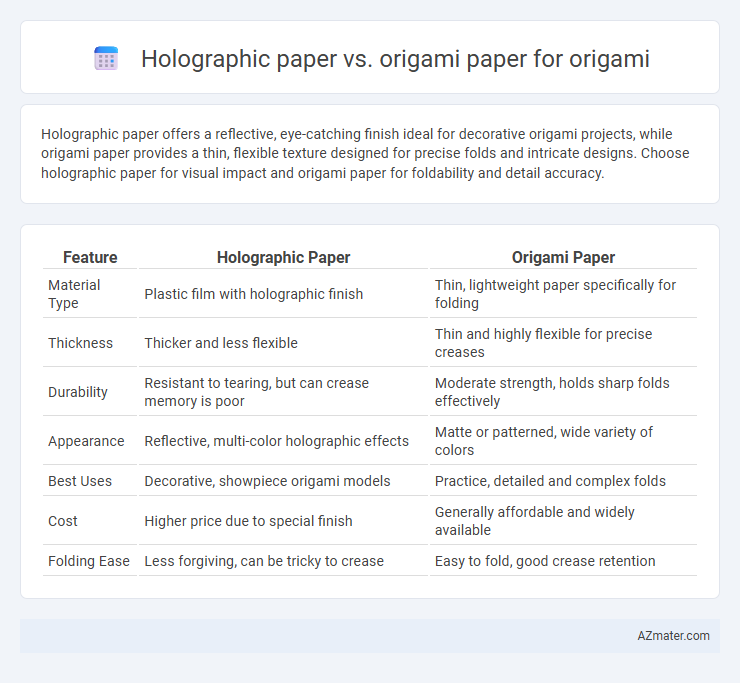Holographic paper offers a reflective, eye-catching finish ideal for decorative origami projects, while origami paper provides a thin, flexible texture designed for precise folds and intricate designs. Choose holographic paper for visual impact and origami paper for foldability and detail accuracy.
Table of Comparison
| Feature | Holographic Paper | Origami Paper |
|---|---|---|
| Material Type | Plastic film with holographic finish | Thin, lightweight paper specifically for folding |
| Thickness | Thicker and less flexible | Thin and highly flexible for precise creases |
| Durability | Resistant to tearing, but can crease memory is poor | Moderate strength, holds sharp folds effectively |
| Appearance | Reflective, multi-color holographic effects | Matte or patterned, wide variety of colors |
| Best Uses | Decorative, showpiece origami models | Practice, detailed and complex folds |
| Cost | Higher price due to special finish | Generally affordable and widely available |
| Folding Ease | Less forgiving, can be tricky to crease | Easy to fold, good crease retention |
Introduction: Holographic Paper vs Origami Paper
Holographic paper features a reflective, shimmering surface that enhances the visual appeal of origami creations, making them stand out with vibrant colors and dynamic light effects. Origami paper, typically thin and lightweight, is designed for precise folds and crisp edges, ensuring structural integrity and ease of manipulation during complex designs. Choosing between holographic paper and traditional origami paper depends on the desired aesthetic impact and folding complexity of the project.
Material Composition and Texture
Holographic paper for origami typically features a thin plastic film coated with a reflective layer, resulting in a smooth, glossy surface that enhances light reflection and color vibrancy. Origami paper, traditionally made from mulberry or rice fibers, offers a matte texture with moderate absorbency, allowing for precise folds and crisp creases without tearing. The material composition of holographic paper often makes it less pliable and more prone to cracking on complex folds compared to the supple, fibrous texture of standard origami paper designed specifically for traditional folding techniques.
Visual Appeal and Finish
Holographic paper offers a striking, reflective surface with vibrant colors that enhance the visual appeal of origami models, creating a modern and eye-catching finish. Origami paper, typically matte or lightly textured, provides a traditional, smooth finish that emphasizes precision and detail in folds. The choice between holographic and origami paper depends on whether the desired effect prioritizes dazzling aesthetics or classic elegance and foldability.
Foldability and Workability
Holographic paper offers a striking, reflective finish ideal for decorative origami but tends to be stiffer, making intricate folds more challenging compared to traditional origami paper. Origami paper is specifically designed to balance flexibility and durability, allowing for precise, complex folds without tearing or creasing improperly. For advanced foldability and ease of workability, origami paper remains the preferred choice, while holographic paper excels in visual impact and simple designs.
Durability and Tear Resistance
Holographic paper offers enhanced durability and superior tear resistance compared to traditional origami paper, making it ideal for complex or intricate folds. Its laminated surface protects against moisture and wear, ensuring longer-lasting models that maintain their shape and vibrancy. Origami paper, while often thinner and easier to fold, is more prone to tearing and damage, especially in detailed or repeated creasing scenarios.
Color Variety and Pattern Options
Holographic paper offers a vibrant spectrum of iridescent colors with dynamic light-reflecting patterns, ideal for creating eye-catching origami designs that shimmer from every angle. Origami paper typically presents a broader range of traditional colors and intricate patterns, including florals, geometric shapes, and thematic prints, providing more versatility for detailed and culturally inspired folds. Color variety in holographic paper tends to emphasize metallic sheens and gradients, while origami paper prioritizes matte and textured finishes with rich, diverse pattern options.
Availability and Cost Comparison
Holographic paper is widely available in craft stores and online but generally costs more due to its glossy, reflective surface and specialty manufacturing process. Origami paper, typically sold in multi-colored packs, is more affordable and easier to find in bulk, making it a cost-effective choice for large projects or beginners. The price difference can influence project budgets, with origami paper being preferred for everyday folding and holographic paper reserved for decorative or gift-enhancing applications.
Suitability for Different Origami Projects
Holographic paper offers a reflective and eye-catching surface ideal for decorative origami projects such as cranes, flowers, and geometric shapes where visual impact is key. Origami paper, typically thinner and more flexible, excels in complex folds and precision, making it suitable for intricate designs like modular origami and detailed animals. Choosing between holographic and origami paper depends on the balance between aesthetic appeal and foldability required for the specific origami project.
User Experience: Beginner vs Advanced Folders
Holographic paper offers a visually striking, reflective surface that enhances the appearance of finished models but tends to be stiffer and less forgiving, posing challenges for beginners struggling with precise folds. Origami paper, typically thin and flexible with a matte finish, provides easier crease formation and better manipulation, making it ideal for novices mastering fundamental techniques. Advanced folders benefit from holographic paper's durability and aesthetic appeal when crafting complex designs, while preferring traditional origami paper for intricate folds requiring high precision.
Final Verdict: Which Paper is Best for Origami?
Origami paper offers superior flexibility and precision, making it ideal for intricate folds and delicate designs, while holographic paper adds a visually striking, reflective finish that enhances the aesthetic appeal but can be slightly stiffer and harder to crease. For traditional origami techniques requiring sharp, clean folds, standard origami paper is best due to its balance of texture and durability. Choose holographic paper when the final visual impact and decorative effect are the focus, but prioritize origami paper for the best overall folding experience and structural integrity.

Infographic: Holographic paper vs Origami paper for Origami
 azmater.com
azmater.com